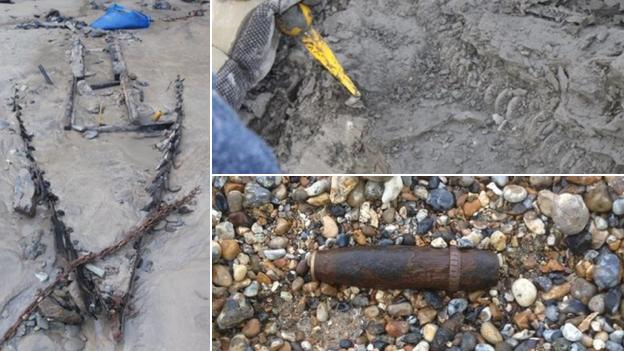Storms unearth hidden treasures and dangers
- Published

Unexploded bombs, rare dinosaur fossils and an unknown boat wreck have been unearthed on England's beaches during the recent stormy weather. But what else could appear on our shores?
Pounding waves and high tides have led to the coastline being eroded and changed beyond recognition.
In the past month, World War Two bombs were washed-up on an Essex beach, a near-complete ichthyosaur skeleton was unearthed in Dorset and in Cornwall a boat wreck was discovered.
But why is this happening and what other hidden treasures - or dangers - are waiting to be revealed?
During the storms, mighty rock stacks and arches have been reduced to rubble, but for some there is a silver-lining to the destruction.
David Sear, who is a professor of geography at the University of Southampton, said: "Storms are disastrous and horrible for many people - but in the cold light of day there's some interesting stuff that's revealed."
Prof Sear led the project investigating the sunken village of Dunwich in Suffolk, dubbed "Britain's Atlantis", which was gradually lost to coastal erosion during the Middle Ages.
He said: "There's a dreadful term - ambulance chasers. People like me phone up people I know in places that are being potentially damaged in bad weather.
"But it's driven by genuine interest, because this doesn't happen that often."
He said a large amount of material being discovered would be from the world wars, which poses obvious dangers.
"There's so much of it - so many mines, and so much metal and concrete beach defences," he said
"There's enormous quantities in the near-shore zone and that's always going to be problematic."
Toby Gane, who is a project manager at Wessex Archaeology, agreed, adding: "We've worked on many aircraft wrecks and the dangers are there might be unexploded ordnance, although this is the case for all military wrecks.
"Where a wreck is exposed to low tide, it might be attractive for people to look around it, but they have to be aware of the dangers."
But he said despite the dangers, they had to be weighed against the benefits of discovery.
"Not all archaeologists or palaeontologists rush out after a storm, but it's under these circumstances that things get found and reported to us and things start happening," he said.
"Some enthusiastic members of the public do go out there and find these things and report them.
"Their actions should be applauded for helping to protect the nation's heritage."
However, he said archaeological discovery is in contrast to treasure hunters or shipwreck salvagers.
In January 2007, goods washed ashore from the stricken container ship MSC Napoli were taken by people in Branscombe Bay, Devon.
Forty containers drifted on to the beach, containing items such as BMW motorbikes, steering wheels and beauty cream.

Motorbikes were among items salvaged in 2007 when containers drifted into Branscombe Bay
But it is the hidden treasure of a more historic kind that could be lurking just beneath the surface that interests Prof Sear.
In 1998 archaeologists discovered "seahenge", on a beach at Holme, in Norfolk.
The 4,000-year-old monument, consisting of an upturned tree stump surrounded by posts, emerged after a peat dune was swept away by storms.
"As the beach levels drop you're going back in time," he said.
"It is when you're stripping away layers of history that it gets exciting."
- Published7 January 2014
- Published7 January 2014
- Published6 January 2014
- Published6 January 2014
- Published6 January 2014
- Published2 January 2014
- Published4 January 2014
- Published1 January 2014
- Published21 December 2013
- Published4 January 2014
- Published19 December 2013